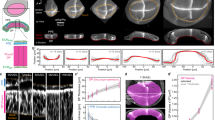Abstract
Some key experiments of artificial production ofsitus inversus viscerum are briefly reviewed and a two-step mechanism for the explanation of the systematic asymmetric visceral arrangement in vertebrates is proposed. A two-variable reaction-diffusion system displaying a symmetry-breaking bifurcation is considered, and it is demonstrated that a slight asymmetry of the boundary conditions can give rise to a marked asymmetry in the resulting dissipative structure in both one-and three-dimensional systems. A criterion is formulated allowing classification of reaction-diffusion systems operating in a three-dimensional space with regard to their ability to incorporate slight asymmetries at the boundaries in the form of a chiral dissipative structure.
Similar content being viewed by others
References
Alberts, B.et al. 1983.Molecular Biology of the Cell. London: Garland.
Auchmuty, J. F. G. and G. Nicolis. 1975. “Bifurcation Analysis of Nonlinear Reaction-Diffusion Equations. I.—Evolution Equations and the Steady State Solutions”,Bull. math. Biol. 37, 323–364.
Frey-Wyssling, A. 1953.Submicroscopic Morphology of the Protoplasm. Amsterdam: Elsevier.
Gierer, A. and H. Meinhardt. 1972. “A theory of Biological Pattern Formation”.Kybern. 12, 30–39.
—, and—— 1974 “Biological Pattern Formation Involving Lateral Inhibition”.Lec. Math. Life Sci. 7, 163–182.
Harrison, R. G. 1969. “Relations of Symmetry in the Developing Embryo”. InOrganisation and Development of the Embryo. New Haven Yale University Press.
Huxley, J. S. and G. R. De Beer. 1934.The Elements of Experimental Embryology. London: Cambridge University Press.
Lehmann, F. E. 1945.Einfuhrung in die physiologische Embryologie. Basel.
Lewis, J., J. M. W. Slack and L. Wolpert. 1977. “Thresholds in Development”.J. theor. Biol. 65, 579–590.
Lutz, H. 1949. “Sur la Production Expérimentale de la Polyembryonie et de la Monstruosité Double chez les Oiseaux”,Arch. Anat. Mic. Exp. 38, 80–143.
Oppenheimer, J. M. 1974. “Asymmetry Revisited”.Am. Zool. 14, 867–879.
Shaller, H. and H. Bodenmuller. 1981. “Isolation and Amino Acid Sequence of a Morphogenetic Peptide from Hydra”.Proc. natn. Acad. Sci. U.S.A. 70, 7000–7004.
— and A. Gierer. 1973. “Distribution of the Head-activating Substance in Hydra and its Localisation in Membranous Particles in Nerve Cells”.Embr. Exp. Morph. 29, 39–52.
Spemann, H. and H. Falkenberg. 1919. “Uber asymmetrische entwicklung und Situs inversus viscerum bei Zwillingen und Doppelbildungen”.Arch. Entw. Mech. 45, 371–442.
Warynski, S. and H. Fol. 1884.Rec. Zool. Suis. I, 1. [Cited by Huxley and De Beer, (1934), p. 78.]
Wilhelmi, H. 1921. “Experimentelle Untersuchungen uber Situs inversus viscerum”.W. Roux' Arch. Entw. Org. 48, 517–532.
Author information
Authors and Affiliations
Rights and permissions
About this article
Cite this article
Almirantis, Y., Nicolis, G. Morphogenesis in an asymmetric medium. Bltn Mathcal Biology 49, 519–530 (1987). https://doi.org/10.1007/BF02460135
Received:
Revised:
Issue Date:
DOI: https://doi.org/10.1007/BF02460135




